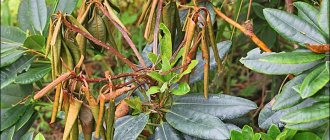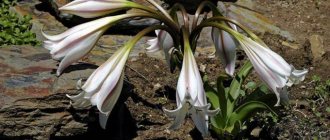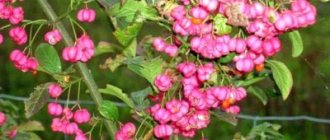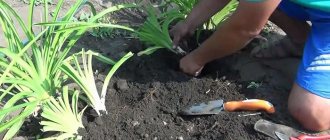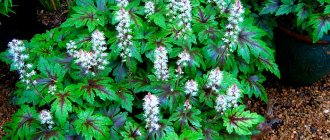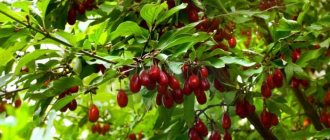The flowering plant hibiscus (Hibiscus) is a member of the Malvaceae family. This genus includes approximately 300 species, among which there are shrubs, evergreen and deciduous trees, and also herbaceous plants. Under natural conditions, they can be found in tropical and subtropical regions of the Old and New Worlds. In open ground in regions with a temperate climate, only trifoliate hibiscus and Syrian hibiscus are cultivated, as well as garden hibiscus (hybrid hibiscus), which was bred by breeders in the forties and fifties of the twentieth century on the basis of North American hibiscus: bright red, swamp and armed. All forms of garden hibiscus are highly resistant to frost. The well-known Chinese hibiscus (Chinese rose) in mid-latitudes is cultivated only in greenhouses or at home, but in the summer it is advisable to move it to fresh air.
Brief description of cultivation
- Landing . In spring, from mid to late May.
- Bloom . From the last days of June to the beginning of October.
- Illumination. Sunny areas are suitable.
- Soil . The soil should be nutritious, light and well drained. Hibiscus can be grown in areas where roses grow well.
- Watering . It is necessary to water systematically, especially on hot days, but do this only when the soil dries out. During the dry season, watering is carried out every day.
- Trimming . In early spring, before sap flow begins, rejuvenating, sanitary and formative pruning is carried out.
- Fertilizer . Hibiscus should be fed from June to September once every 2 weeks; for this purpose, mineral fertilizers with a high content of nitrogen and phosphorus are used. In autumn, potassium fertilizer should also be added to the complex.
- Reproduction . By cuttings, grafting, layering and seed method.
- Harmful insects . Thrips, spider mites, aphids and whiteflies.
- Diseases . Root rot and chlorosis.
Fertilization and flowering characteristics of street hibiscus
Street hibiscus needs abundant feeding with phosphorus and nitrogen fertilizers in the first year of life. It is carried out every fourteen days, that is, twice a month. Closer to the autumn months, potassium fertilizers are applied, and phosphorus fertilizers are reduced to a minimum. The large (main) flower on hibiscus blooms only for one day, but the crown is constantly strewn with inflorescences. If the bush is provided with proper and proper care, new buds always appear on it. When they fall off, it means that either there is not enough feeding, or the plant is affected by parasitic organisms.
Features of garden hibiscus
Garden hibiscus is represented by shrubs, trees and herbaceous plants. For example, tree hibiscus (Syrian rose) is cultivated in the garden as a standard tree or shrub, the height of which can reach up to 150 cm. All herbaceous hibiscus are represented by varieties of hybrid hibiscus, among them there are annuals, but perennials are the most popular among gardeners. Despite the fact that there are a large number of different forms of such a plant, they all have common features. The petiole leaf blades are cut to a greater or lesser extent. Large, richly colored flowers can be simple or double. They can be painted in various colors, for example: yellow, dark red, blue, purple, white, crimson, lilac or violet. There are varieties with an eye of contrasting color or with a border along the edge of the petals. The fruit is a five-leaf capsule containing seeds. Today, in addition to garden species, there are approximately 500 varieties and forms of hibiscus.
Syrian hibiscus: planting and care
Choosing a place and time for planting garden hibiscus
The plant should not be planted in a shaded area. It refers to light-loving. The place is chosen open to sunlight. The main thing is that it is well protected from the wind. Regarding the soil, there are no special requirements. Hibiscus loves moisture, but the composition of the soil is not particularly important. The only nuance to remember is that water should not stagnate around the rhizome. In other words, it should be quite loose, and not “stoney”. The best time for planting is spring, but not early. This is due to the fact that the earth must be warmed by the sun.
Planting hibiscus in open ground
What time to plant
Before you start planting hibiscus, you need to choose the most suitable place for this. How long it will decorate your garden depends on this, as well as how well you care for the plant. If everything is done correctly, the bush can grow in the same place for about 20 years.
Hibiscus seedlings are planted in open ground in the spring, after the spring return frosts are left behind. In this case, during the summer the bush will be able to take root well and acclimatize in a new place. It is best to choose a well-lit place for planting a crop that is reliably protected from the wind. The soil should be light, rich in nutrients and well-drained; roses still grow well in such soil. If desired, hibiscus can even be planted among roses.
Landing rule
To plant a tree-like form, the planting hole must be 2 times larger than the volume of the seedling's root system. After the hole is ready, a layer of drainage made from pieces of brick must be laid on its bottom; its thickness should be approximately 15 centimeters. It is covered with a 10-centimeter-thick layer of sand on top, then a fifteen-centimeter layer of compost, and again a ten-centimeter layer of sand. To fill the planting hole, you will need a soil mixture; to prepare it, combine the soil pulled out of the hole, sand and peat in a ratio of 2: 1: 4. Carefully place the seedling in the hole, with the root collar only slightly immersed in the soil. Then the hole is filled with the soil mixture that you prepared in advance.
After the tree is planted, it needs to be well hilled, as a result there should be a fairly deep hole for water around it. Pour water into this hole and wait until it is completely absorbed into the soil. Then fill the hole with soil so that the tree trunk circle is even and flush with the surface of the area.
If you need to plant a seedling in open ground in the autumn, then the surface of the tree trunk circle should be covered with a layer of mulch, and the plant itself should be tied with spruce branches.
Care
In order for the standard Chinese rose to bloom lushly, it is necessary to properly care for the crop. The following describes the features of caring for a tree plant.
Watering and spraying mode
Garden balsam - planting and care in open ground
To moisten the soil, it is necessary to use rain or settled river water with a low level of hardness. Hibiscus needs moderate watering. It is important to pay attention to the condition of the top layer of soil. On particularly hot summer days, it is necessary to moisten the soil every day. The rest of the time, it is enough to water the Chinese rose three times a week.
Note! The foliage can be watered with a hose to remove dust deposits. This procedure will also be an excellent prevention of the appearance of spider mites.
In the case of mass falling of flowers, we can talk about severe drying out of the earth. To prevent plants from being damaged by chlorosis, it is necessary to moisten the soil with water containing a small amount of iron.
There is no need to worry if a small number of beautiful flowers fall off. This is normal, as new ones will bloom to replace them. Mass falling or falling of buds that have not opened may indicate a problem. The cause of this problem is the incorrect watering regime.
Important! Moistening the soil with water containing cigarette ash will help control aphid infestations. The pest does not like the aroma of tobacco products, so it will soon leave the flower.
Growing hibiscus near lavender will be an excellent prevention against pest invasion. Its delicate aroma repels most insects.
Standard tree
Preparation for wintering is an important stage
Before the winter cold, the tree-like Chinese rose sheds its leaves. The perennial grown in central Russia does not reach a height higher than 200-210 cm. The variety is quite frost-resistant, so the likelihood of freezing in the southern regions is minimal.
If the perennial grows in the middle zone, it is better not to risk it and prepare the hibiscus for wintering. Before sheltering, the plant must be watered abundantly (about 12-15 liters of water will be required). As soon as the soil dries, the hibiscus must be hilled as high as possible. It is advisable to add a small amount of sand to the ground before doing this. As soon as the first frosts begin, the soil in which the Chinese rose is grown is covered with a layer of:
- shavings;
- sawdust;
- dry leaves.
The thickness of the bedding layer should be within 18-20 cm.
The branches are pressed as low as possible to the soil. The perennial is wrapped in dense non-woven material. It is best to make several rows of winding. Next, you should build a frame and throw insulating material and coniferous spruce branches on it.
For your information! In temperate latitudes, the Chinese rose can only overwinter with an insulated root system. However, it is still better to install the frame. In case of unexpected frost, you can quickly throw on insulation and save the plant from freezing.
Growing in a continental climate does not imply overwintering the perennial outside. Siberian frosts will destroy the plant. Back in early November, the bush is very carefully dug up. Under no circumstances should damage to the root system be allowed. The plant is dug up with a large lump of soil and transferred to a large tub. After this, the tree hibiscus goes into the basement for the whole winter. You can additionally insulate the root system with non-woven material.
Chinese rose care
Hibiscus care
Garden hibiscus grown in open soil is not at all difficult to care for. After young green stems appear on the bush, all dried old shoots are cut off from it. Systematically loosen the soil around the tree, pull out weeds in a timely manner, and also prevent the bush from thickening.
Fertilizer
During the growing season (June–September), the plant is regularly fed once every 2 weeks, using fertilizer with a high content of phosphorus and nitrogen. And in the autumn, when preparing the bush for wintering, in addition to phosphorus fertilizers, it is also fed with potassium fertilizers.
Once the flower blooms, it will only live for 24 hours and then wither. However, if the bush is given good care, it will bloom very luxuriantly, and immediately after one flower withers, another will bloom. In order for the bush to always be neat, you need to regularly pick off the flowers that have begun to fade.
Watering
In order for the flower to grow and develop normally, it must be watered in a timely manner; special attention is paid to this in hot weather. However, watering is carried out only when the surface of the soil around the bush is completely dry. If there is a long dry period, water the hibiscus every day.
Hibiscus pruning
The crop needs sanitary as well as formative pruning, with which you can give the desired shape to the bush. Most often it is given the shape of a tree, but this will require a lot of time and patience. In a newly planted young bush, the branches are shortened to 2 or 3 buds, while the well-developed trunk does not need to be touched. In subsequent years, in the last weeks of winter, prune the side shoots to 1–2 buds, and the stem to 5–6 buds. After the height of the stem suits you, begin shaping the crown of the plant; to do this, shorten strong shoots by several buds. Cut out all the lower shoots, and also trim the upper part of the stem.
In the first weeks of spring, before sap flow begins, sanitary pruning of hibiscus is carried out. To do this, cut out all disease-affected, old, weak shoots growing inside the bush, then shorten last year’s growth by 1/3, this helps stimulate the formation of new flower buds. The main rule in pruning hibiscus is that the more the bush is pruned, the more young shoots it will grow, and this will lead to more luxuriant flowering.
If you need to rejuvenate a plant, then to do this, all the dried old branches are cut off, and the remaining stems inside the bush are shortened by 2/3. To make the shape of the bush more attractive, it is recommended to cut the branches around the main stem to different heights.
Hibiscus transplant
Sometimes it happens that an adult hibiscus bush has to be transplanted to a new place. This is done in early spring after all the shoots have been shortened by ½ part and always before the bush blooms. Transplantation is carried out in the same way as planting (see above).
After the plant is transplanted, it is well watered. In the future, it is cared for in the same way as other adult hibiscus. After a year, flowers will appear on the bush. When transplanting a hybrid hibiscus, if desired, you can divide the rhizome.
Syrian hibiscus - my secrets of care
What plants does street hibiscus “get along with”?
Some gardeners prefer to plant hibiscus separately, while others, on the contrary, strive to create beautiful compositions. The latter, when engaged in landscape design, should strive not only to plant the plants they like, but to take into account the fact that not all of them can feel great next to each other. Garden hibiscus grows and blooms most favorably next to lavender and roses. Such a neighborhood will not bring any additional hassle in caring for the plants, but will allow you to form a wonderful composition that will decorate your garden or suburban area.
Reproduction of garden hibiscus
Even a novice gardener can propagate garden hibiscus, as there is nothing complicated about it. Syrian hibiscus (garden) is most often propagated by seed and cuttings, but this can also be done by grafting and layering. Hybrid hibiscus can be propagated by grafting, dividing the bush, and also by green cuttings.
Growing from seeds
Hibiscus seeds are sown in January–March. Before starting sowing, the seed material is poured with a dark pink solution of potassium permanganate for 30 minutes. Then they are taken out and immersed in Epin solution for 24 hours so that the seeds are only slightly covered with it. Then the seeds are sown. To do this, use a container that is filled with a soil mixture consisting of sand and peat. It is covered with glass on top and put in a warm place (from 25 to 27 degrees). If possible, arrange bottom heating for the crops. They will also need systematic ventilation and removal of condensation from the shelter. Watering is carried out as necessary.
After the seedlings have formed their first true leaf blades, they will need to be planted into individual pots. Make sure that the plants do not stretch out. This can happen due to excessively poor lighting, so it is recommended that seedlings receive additional lighting.
Seedlings are planted in open soil in mid-May. Powerful bushes are immediately planted in a permanent place. Those seedlings that are very weak are recommended to be planted on a training bed for growing, and the distance between the bushes should be at least 50 cm. Unlike hybrid hibiscus, garden hibiscus can reproduce by self-sowing.
Propagation of hibiscus by cuttings
Preparation of cuttings is carried out in the summer. To do this, cut off a shoot with 2–3 internodes. Treat the lower edges of the sections with a growth stimulating agent. After this, they are planted in a peat soil mixture in a greenhouse for rooting; they will need bottom heating. After 4 weeks, roots should grow on the cuttings, after which they are transplanted into separate containers, which are filled with a soil mixture consisting of peat, sand, turf and leaf soil (1: 1: 1: 1). Systematically water the bushes, and after they grow young shoots, they are pinched, which stimulates tillering.
After the bush has grown and become stronger, it can be planted in the garden. With proper and good care, hibiscus will begin to bloom in the first year after planting it in open soil. Some gardeners are able to root cuttings in a container of water.
Syrian hibiscus. Propagation by cuttings. Wintering
Reproduction
Garden hibiscus can be propagated using:
- Rhizomes. By dividing it. This is the easiest way to reproduce. To do this, you need to dig up the plant and determine the main root. Mark the location of the cut so that the small annual roots are preserved. Chop the root into pieces. Ash is sprinkled on the cut to prevent it from rotting. The resulting root is buried in a hole, cut side down, and watered with warm water.
- Using cuttings. Woody branches are cut off along with the buds in the spring. Place in a container with a special solution. It must be changed periodically. When a large number of roots are formed, they are transplanted into a pot with soil.
- Using seeds. The herbaceous hibiscus is most suitable for this type of propagation. The seeds must be soaked for 10-12 hours in a special solution for root germination. Then they need to be washed in a weak solution of potassium permanganate, dried, and wrapped in cloth and polyethylene. Place in a warm place and ventilate periodically. After the first shoots have already appeared, plant them in the ground. They need good care.
Pests and diseases of hibiscus
Pests
Hibiscus is quite resistant to pests and diseases. However, if during a prolonged drought it is not watered for a long time, then aphids, spider mites, thrips and whiteflies can settle on it. In order to get rid of harmful insects, you will need to spray the bushes with a solution of an insecticidal preparation, for example: Fitoverma, Karbofos, Aktellika or Inta-vira, 2 times with an interval of 7-10 days.
Diseases
Most often, hibiscus grown in open ground is affected by chlorosis. In a diseased bush, the lower leaf plates fly off, while the young leaves immediately grow pale yellow. This may occur due to the fact that the soil contains very little iron and nitrogen; therefore, it is recommended to add iron chelate to the water during irrigation. At the same time, in the spring, it is necessary to apply a complex mineral fertilizer, which contains nitrogen, to the soil.
Possible problems
- Hibiscus is turning yellow . Hibiscus leaves may turn yellow if its root system was injured during transplantation, or also due to chlorosis. If the yellowing of the foliage is associated with injury to the root system, then during watering you need to add Kornevin or Zircon to the water, and you must follow the instructions attached to the drug, and also pour the product into the water used to moisten the leaf blades (6 drops per 1 liter of water ). Also, yellowing of the foliage may be due to insufficient watering during a prolonged drought.
- Hibiscus does not bloom . If a spacious, well-lit area has been chosen for planting a bush, and the gardener properly cares for it and follows all the rules of agricultural technology, but flowers still do not appear on it, then this may be due to the fact that there is very little in the soil boron and phosphorus. And if, in addition to the lack of flowering, the stems also grow very slowly, then the bush still does not have enough nitrogen. If you feed hibiscus correctly and in a timely manner, it will certainly bloom.
- Hibiscus leaves are falling . The loss of leaves in autumn is a completely natural process, and you should not worry about it. However, if the foliage begins to fall earlier than expected, this may be due to the fact that the root system is damaged or due to improper watering (both excessive and insufficient). How to correct the situation is described in detail above.
Features of street hibiscus
Designed for outdoor cultivation, hibiscus is covered with oval leaves with pointed edges. Large funnel-shaped flowers have petals of various colors. There are several types of this plant. Breeders highlight:
- Syriac . It has rich green foliage. Feels great in open ground. Its crown grows slowly, and flowering begins only in the third and sometimes in the fourth year.
- Trifoliate . Reaches a height of one meter, but can grow larger. The foliage resembles petioles and is small. Flowering is long-lasting, but the small yellow flowers only bloom for a few hours during the day.
- Drummond . Large leaves up to five centimeters in diameter frame branched stems. The flowers, consisting of five petals, are pink in color with a blackish core.
- Dissected petal . It got its name from the shape of its petals. It has medium-sized flowers of orange or red color. The bush blooms until autumn.
Thanks to the variety of species, every gardener can choose exactly the hibiscus whose appearance best fits into the landscape of their garden plot.
Hibiscus after flowering
Features of care in autumn
Perennial hybrid hibiscus are all highly resistant to frost. They can be cultivated throughout Ukraine, while in Russia such a plant can only be grown in regions located south of Moscow, and then they must be covered for the winter.
The above-ground part of the bush that has died off in autumn is cut off almost to the surface of the area. Then the remaining section is piled high with soil. If a winter that is too frosty or with little snow is expected, then cover the surface of the tree trunk circle with a layer of mulch (flying dry leaves or sawdust). With the onset of spring, hybrid hibiscus will grow young stems, and many spectacular flowers will appear on them.
Wintering
But what if you grow Syrian (garden) hibiscus? When cultivating in mid-latitudes, the bush must be covered for the winter, especially if you grow a terry variety. In regions with a very cold climate, the bush can be removed from the ground for the winter, placed in a large pot or container and stored in any cool room (for example, a basement), where it will remain until spring. Then it is planted again in the garden.
If your plant will winter in the open ground, then in the 2nd–3rd decade of November, after the air temperature remains at a level of minus 5 to minus 10 degrees, you need to make a frame around the bush, spunbond, lutrasil or agrotex is stretched over it. If in the region where you live, in winter the air temperature does not drop below minus 15 degrees, then the bushes protected in this way are not in danger. Instead of a covering material that does not allow air to pass through well, which can cause the plant to die, it is better to use spruce branches, which can accumulate snow on itself and prevent the hibiscus from overheating or rotting. First, tie the bush with a rope, and put a sackcloth bag on top of it, then lay the spruce branches in 3 layers, like a hut. But it should be taken into account that a rodent can get into such a structure and gnaw the bark on the plant, and it will die. To protect the bush from such a pest, you need to place mousetraps or bait (wheat poisoned with rodent poison) near it.
Syrian hibiscus. Preparing for winter.
The most important thing is wintering
The wintering strategy for garden hibiscus depends on their winter hardiness:
- Herbaceous hybrid and bush Syrian hibiscus do not need much shelter; as they age, they can be covered with only minimal hilling or not covered at all.
- Low-winter-resistant old Syrian hibiscus and capricious varieties not from your region can only overwinter in the garden at a very mature age and with strong shelter, but it is better to grow them as annual plants or take them indoors for the winter.
- Do the same if you are not sure about the frost resistance and origin of the plant (or you have acquired a very beautiful, but initially capricious variety). It is better to dig up the hibiscus along with a large lump of earth, move it into a container and store it in a cold, but frost-free and bright room.
- Potted and indoor hibiscus are taken indoors with a short adaptation period as soon as there is a threat of night frosts. They are best grown during the cold season as indoor plants or placed in a frost-free room with access to light.
The preparation of herbaceous hibiscus differs from the preparation of bushy and tree-like plants: they are cut to a height of about 10-15 cm above the soil level and mounded to the full height with foliage or mulched with dry, light soil. This will be enough for wintering.
A distinctive feature of tree and bush hibiscus is the ability to become more and more frost-resistant with age. With good care and cultivation without replanting, hibiscus will become completely winter-hardy after a few years, and old bushes will not suffer at all even from the most severe frosts. But keeping plants to maturity is a difficult task and requires constant vigilance. Hibiscus are especially sensitive in the first year after planting, but even before 4-5 years of return, you should not take risks and leave them without shelter.
On a note. Hibiscus, especially hybrid ones, produce leaf buds and show signs of growth very late, most often only in May, and sometimes they wait until summer. The absence of leaves should not be taken as a signal that the plant did not survive the winter: do not worry until June and only then draw conclusions. Moreover, the younger the plant, the later it will wake up.
Syrian hibiscus (Hibiscus syriacus). © 99roots
In the conditions of the middle zone, hibiscus needs to be covered at least minimally for the winter - covered with dry leaves to preserve at least the lower parts of the shoots. Wrap young hibiscus, as well as all bushes in which you want to prevent above-ground shoots from freezing, more carefully for the winter:
- Mulch the soil around the plant with plant materials, and mound the stems as high as possible with dry leaves.
- Wrap the hibiscus in spruce branches, tying it with twine (or better yet, strengthening it with burlap), creating several layers of cover. Do not use non-woven materials: they will increase the risk of damping, so it is better to give preference to simple burlap.
Most adult frost-resistant Syrian hibiscus capable of growing in open soil in regions with harsh winters without shelter for the winter successfully survive, retaining only the rhizome and renewal buds. But there is no need to be afraid of the death of the above-ground part: hibiscus blooms on new shoots, recovers well and the foliage grows again. Thanks to their rapid growth, the bushes bloom no worse than plants that retain all above-ground parts during the winter, although they do not reach the size and beauty of covered hibiscus. But if you have the opportunity (and desire) to completely cover even the most mature hibiscus for the winter and thus preserve the above-ground parts of the plant at least partially for next year, be sure to use it.
Don’t rush with hilling and covering: hibiscus is not afraid of light frosts; moreover, the plant should be allowed to harden a little on its own before wrapping. November is considered the ideal time to cover hibiscus, but it is better to focus on the temperature: cover the plant when stable frosts set in -5-10 degrees. It is better to create shelter at intervals, in several passes - first by mulching, then by hilling, and only then by spruce branches. And even huts can be created from it in 1-2 passes.
Types and varieties of Syrian hibiscus with photos
As mentioned above, Syrian hibiscus, as well as its varieties, are most often cultivated in the garden. But other types of such plants and their various varieties are also grown in open ground.
Syrian hibiscus (Hibiscus syriacus)
The birthplace of this plant is not Syria, but China. Under natural conditions, this species is a deciduous shrub that can reach 5–6 meters in height. The shape of the rich green leaf blades is ovoid, and their length is up to 10 centimeters. During flowering, single flowers bloom, which can be painted in different colors. Gardeners cultivate hibiscus with both simple and double flowers, and the plant form can be either standard or bush. The best varieties:
- Diana . The height of the bush is about 200 cm. White flowers reach 12 centimeters in diameter, the edges of their petals are wavy.
- Vayelit Ilar Double . This upright, powerful shrub is decorated with semi-double or double flowers of bluish-violet color with red spots in the middle.
- Pink Giant . Pink single flowers have a purple spot at the base.
- Carneus Plenus . The stems of this shrub are very flexible. Double flowers of a pale pink hue are decorated with a crimson spot located in the middle.
Trifoliate hibiscus (Hibiscus trionum)
This species is native to North and Central Africa. However, today it is widely cultivated in all areas of irrigated agriculture. Hibiscus has a tap root, as well as a branched straight stem, the height of which is about 0.8 m. There is pubescence on the surface of the alternately arranged tripartite leaf plates, and they also have a petiole. The pale yellow flowers reach about 40 mm in diameter and have a dark red center. This species has one characteristic feature: its flowers open in the morning and close in the afternoon. The flowering period of such a plant is more than 30 days. The fact is that new buds form in the axils of each leaf blade, and if the bush grows in favorable conditions, then the formation of flowers will occur every day.
Hybrid hibiscus (Hibiscus hybrida)
In addition to these species, which can be found in the garden and in natural conditions, gardeners also cultivate hybrid hibiscus, as well as its varieties. It was already mentioned above that breeders obtained this plant by crossing 3 North American species, namely: bright red, armed (holly) and marsh hibiscus. Hybrid hibiscus are herbaceous perennial plants that produce very large and beautiful flowers when they bloom. Popular varieties:
- Youth . The height of the weakly branched plant is about 150 cm. The stems are painted in a pale greenish-yellow color, and shoots extend from them at an angle of 60 degrees. Three-cut or five-cut leaf plates are painted greenish-yellow. Pink flowers have a white bowl and bottom, they reach up to 100 mm in diameter and have a tulip shape.
- Late . Such a compact, densely leafy bush reaches a height and diameter of about 100 cm. The shape of the leaf blades with a jagged edge is oval-arrow-shaped, their petioles are thick, and the veins are light in color. Pinkish-crimson flowers with a lilac tint have the shape of narrow bells, they reach up to 70 mm in diameter. Flowers are formed on thick short peduncles.
- Pale pink . The height of the herbaceous bush is about 1.7 m; short shoots extend from the stems at an angle of 60 degrees. The foliage is three-cut, it has a greenish-yellow color. Pink tulip-shaped flowers reach about 12 centimeters in diameter, their bowl and bottom are white.
- Pink porcelain . The height of the bush with greenish-yellow branched stems is about 1.3 m. The middle lobe of the deeply cut leaf blades is wide and protruding, they are painted in a dusty greenish-yellow color, and their petioles reach up to 60 mm in length. Large pinkish, bell-shaped flowers with a barely visible yellowish tint sit in bunches on short peduncles; they reach about 12 centimeters in diameter.
